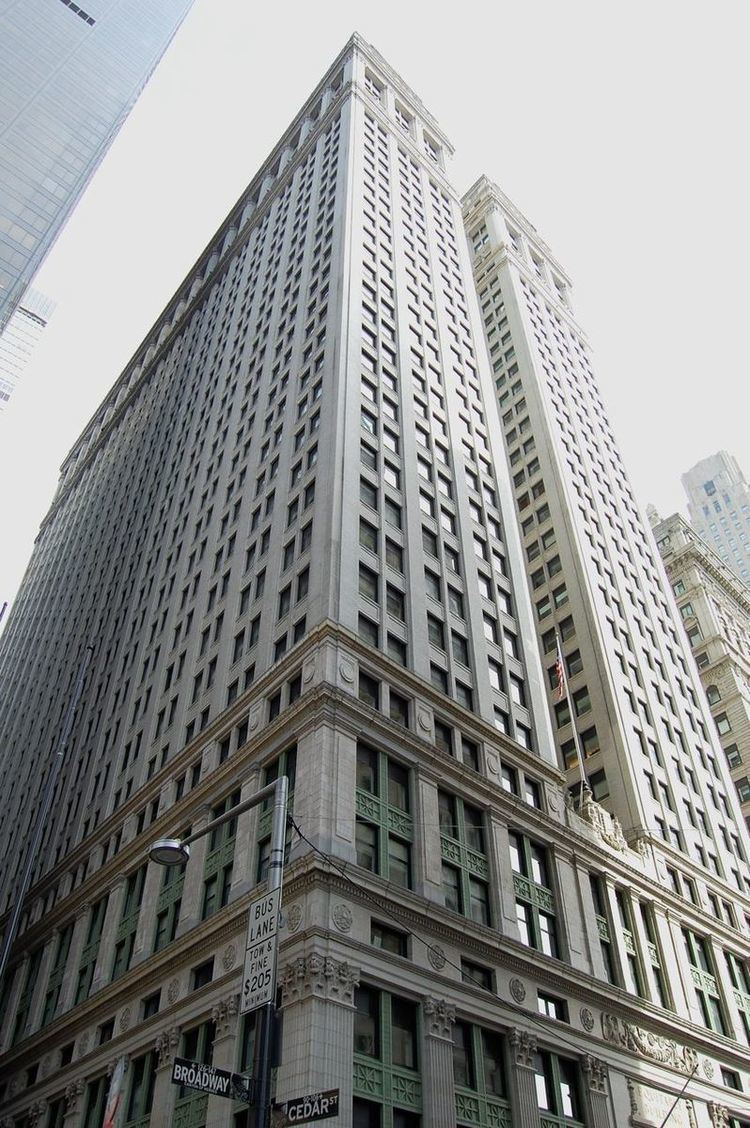Built 1913-15 Added to NRHP June 2, 1978 Designated NYCL June 25, 1996 Architectural style Neoclassical architecture | NRHP Reference # 78001869 Designated NHL June 2, 1978 Height 169 m | |
 | ||
Hours Open today · Open 24 hoursSaturdayOpen 24 hoursSundayOpen 24 hoursMondayOpen 24 hoursTuesdayOpen 24 hoursWednesdayOpen 24 hoursThursdayOpen 24 hoursFridayOpen 24 hours Similar Equitable Life Building, American Surety Building, Singer Building, Adams Express Building, City Investing Building | ||
The Equitable Building is a 40-story office building in New York City, located at 120 Broadway between Pine and Cedar Streets in the Financial District of Lower Manhattan. A landmark engineering achievement as a skyscraper, it was designed by Ernest R. Graham – the successor to D. H. Burnham & Company – with Peirce Anderson as the architect-in-charge, and completed in 1915, when it was the largest office building in the world by floor area: on a plot of just less than 1 acre (4,000 m2), the building had 1.2 million square feet (110,000 m2) of floor space. Built to be the headquarters of the Equitable Life Insurance Company, the controversy surrounding its construction without setbacks, which does not allow sunlight to reach the surrounding ground, contributed to the adoption of the first modern building and zoning restrictions on vertical structures in Manhattan, the 1916 Zoning Resolution. Although it is now dwarfed by taller buildings in its vicinity, it still retains a distinctive identity in its surroundings on Lower Broadway.
Contents
The building was designated a National Historic Landmark in 1978, and a New York City landmark in 1996. It was restored in 1983-90 by Ehrenkrantz, Eckstut & Whitelaw.
Description
The building is in the neoclassical style, rising 538 ft (164 m) with a total floor area of 1,849,394 square feet (176,000 m²), giving a floor area ratio of 30. Upon its completion, the building was the largest (in total floor area) in the world. It rises as a single tower with the appearance of two separate identical towers standing side by side, connected by a wing for the whole height of the building, such that it appears in the shape of the letter "H" when viewed from above. It has no setback from the street beyond the depth of the sidewalk, rising vertically for all its floors.
The building has a through-block entrance lobby with a pink marble floor, sand-colored marble walls and a vaulted, coffered ceiling. It has approximately 5,000 windows. It originally housed the exclusive Bankers Club on its top three floors. The white marble of the building is Yule marble, quarried in Marble, Colorado, which is also the source of the marble used for the Tomb of the Unknowns and the Lincoln Memorial.
The building occupies the entire block, and is bordered by Broadway to the West, Cedar Street to the North, Nassau Street to the East, and Pine Street to the South.
History
The building was constructed as the headquarters of The Equitable Life Assurance Society of the United States. The site had previously been intended in 1906 for a 62-story tower designed by Daniel H. Burnham, but the project had been postponed. When the Equitable's previous headquarters, the Equitable Life Building was destroyed by fire in 1912, the same site at 120 Broadway was chosen as the location for its new headquarters building. It was originally intended to be 40 stories high, but it was reduced by four floors on the advice of consulting engineer Charles Knox, who determined the lower height as being optimal for its elevators.
The building is currently listed as "40 storeys" and "40 floors".
Opponents of the buildings were outraged at the unprecedented volume of the building, which cast a 7-acre (28,000 m²) shadow on the surrounding streets, casting a permanent shadow on the Singer Building up to its 27th floor, the City Investing Building up to its 24th floor, and completely cutting off sunshine to at least three other buildings shorter than 21 stories. Many New Yorkers reasoned that further construction of buildings like it would turn Manhattan into an unpleasant and dark maze of streets. In response, the city adopted the 1916 Zoning Resolution which limited the height and required setbacks for new buildings to allow the penetration of sunlight to street level. (Ironically, the building currently houses the offices of the New York City Department of City Planning.) Specifically, new buildings were afterwards required to withdraw progressively at a defined angle from the street as they rose, in order to preserve sunlight and the open atmosphere in their surroundings. As a consequence of the new restrictions, the building remained the largest office building by floor area in the world until the construction of Chicago's Merchandise Mart in 1930.
The effort to place restrictions on land use in New York City led to the Standard State Zoning Enabling Act, a key piece of legislation in the history of zoning. The act became the blueprint for zoning in the rest of the country, and was accepted almost without change by most states.
In March 1942, a seven-inch (17 cm) shell struck the 37th floor of the building but caused little damage and no injuries. The shell was one of eight fired by an anti-aircraft battery near the East River by mistake. The other rounds all fell harmlessly into the river. On May 29, 1962, four window cleaners were killed when a scaffold fell from the 19th floor of the building.
Current status
The Equitable Building is owned by Silverstein Properties, Inc. After buying the building in 1980, Larry Silverstein had the building renovated and restored at a cost of $30 million, with renovations completed in 1990.
The stretch of lower Broadway where the building sits has since become the traditional route of ticker-tape parades in Manhattan. The route past the building is known colloquially as the Canyon of Heroes, in part because of the sheer verticality of the building and others around it.
